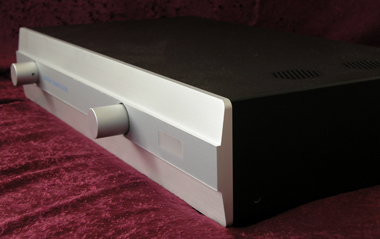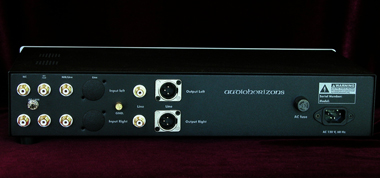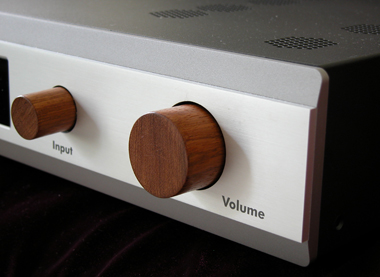Sometimes we are lucky by being in the right place at the right time. In this case, I happened to see the AudiogoN ad for Audio Horizons gear and clicked on the link to their Web site. Seeing the name of Joseph Chow, a long-time audio hardware engineer and a name I recognized, I researched his current products with great interest. In the past, Mr. Chow designed FM tuners for Kenwood and Proton. As an outside design consultant, he developed interconnect cables that sold for $2000 per pair by a well known cable manufacturer. His current product range includes both a solid state and a tube DAC, a tube phono preamplifier, a tube line preamplifier, and a complete line of audio cables, all marketed under his Audio Horizons brand name. I requested the fully loaded phono and line stages for review.

Fully loaded? The TP 8 phono stage is available in several versions. None include a power cable under the probably correct assumption that you do not use the $2 cords that come with most gear. The basic unit sells for $550 factory direct. Upgraded versions include moving coil inputs, upgraded input transformers, additional noise suppression, power supply upgrades, proprietary capacitors, and premium Siemens ECC188 tubes. The unit under my review microscope had all of these upgrades and carries a list price of $1820. You can also get a built-in volume control for direct connection to a power amplifier, which eliminates the need to have a line-stage preamplifier if your turntable is your only source component. The TP 8 is a zero-feedback design which helps to solve problems with time smearing and phase shift. Mr. Chow believes that a key specification and design goal is low noise and his phono stage has an outstanding signal-to-noise ratio of about -90 dB. That is a truly exceptional spec. For comparison, the universally praised Manley Steelhead has a s/n of about -78 dB for MC cartridges at an equivalent gain setting.
Cartridge loading is accomplished by inserting special RCA plugs into designated jacks on the rear panel. This is the same system used for many years by CAT, and one that I appreciate since it makes changing loading quick and simple. Channel separation is rated at 70 dB, which far exceeds the capabilities of even the best phono cartridges. And total harmonic distortion, a favorite spec of high-feedback solid state component makers, is 0.06%. In every regard, this unit appears to break new ground for a tube phono stage. Let’s see if the sonic performance lives up to the paper performance.
The review system included a SOTA Cosmos IV vacuum turntable with TriPlanar VII tonearm, Benz LP and Denon 103R moving coil phono cartridges, Manley Steelhead phono preamp, Placette Passive Line Stage and, near the end of the audition, a highly modified Audio Research LS22 line stage preamp. (This was ARC’s almost last use of the 6922 tube before jumping on 6H30 bandwagon. Many audiophiles lament the adoption of the 6H30 by ARC, Conrad-Johnson, BAT, and others.) Power amplifiers included the Response Audio Bella EXtreme 100 and Manley Neo-Classic 250. The speakers were Gallo Reference 3.1 which received their electron flow via Audience Au24 speaker cables.
Interconnects were either PS Audio Resolution Transcendent RCA or Audio Horizons Transparency. For listening pleasure, I usually preferred the Audio Horizons interconnect on the Steelhead and the PS Audio cables on the TP 8 phono stage. However, all comparisons for this review were done using PS Audio Transcendent. I continued to use the relatively warmer sounding Transcendent for digital and between pre and power amplifiers, mainly to keep variables to a minimum. The Audio Horizons IC gave a slightly crisper sound with just a hair better focus than Transcendent, giving up a touch of bloom and warmth in the process. Power cords included PS Audio xStreme Statement, my own DIY brew, and Audio Horizons Transparency power cord. The $285 Audio Horizons Transparency is – preliminary result – possibly the best of the 3 power cords. Given these results for the Audio Horizons interconnect and power cord, it seems that Mr. Chow knows how to build good cables. (As I write this, I am breaking in Joseph’s balanced interconnect cable for an upcoming shoot-out. Stay tuned.)

Is this on? Did I select “phono” on the preamp? It is impossible to tell because background noise is absent. There is not even a trace of hiss unless I turn the volume control above 3:00. Very LOUD listening in my system is with the volume control at about 12:00. The first things we hear are the differences between the new arrival and the previous component. Compared to the $7300 Steelhead, the TP 8 has a bit more power in the lower bass, a slightly recessed lower midrange, and a bit less harmonic richness in the upper midrange. These traits make the TP 8 sound relatively cooler than the Steelhead, but without any forwardness that usually results from some emphasis in the upper midrange and lower treble. The overall quality of the music was comparable to the much more expensive reference. (Please read that last sentence again.) Some owners have abandoned the Steelhead because, to them, it sounds dark and lacking in air and sparkle. If this describes your impression of the Manley phono stage, you might find happiness with the TP 8. All components have some character, and the TP 8 has less of it than the $5000 EAR 88PB.
As the hours drifted by and comparisons were set aside, I focused on the sonic performance of the TP 8 on its own. With any genre of music, the TP 8 is very dynamic. It easily handles small ensembles, presenting minor changes in the force applied to piano keys, for example, with a clarity that enables the listener to understand the music’s quiet emotion and gain a solid understanding of the artist’s intent. Orchestral crescendos are presented with awesome power and detail which often startled me enough to make my head snap up and stop taking notes. For either micro- or macro-dynamics, the TP 8 is faultless.
Partly due to the absence of noise, low level resolution is outstanding. I hear real sounds, not some effect of an error in the frequency response, that are hard to hear with the Steelhead. In fact, on several occasions I reconnected the Steelhead to verify that something new was really being offered by the TP 8. On intent listening, the more expensive phono stage didn’t really miss anything, but there are some sounds, such as the background tapping of bells or notes on a xylophone from the rear of the stage, that are presented in greater relief with the Audio Horizons phono preamplifier. Lead vocals stand out a bit more from background singers than they do with the Steelhead. Strangely, this high resolution does not make record surface noise more obvious. Just the opposite is true in that record noise is separated from the music and pushed aside. Sibilants are crisp and clean with no sense of degenerating into white noise hash. This works to the benefit of good recordings. As you might expect, poorer recordings, especially some older multi-track studio mixes could occasionally be a bit harsh, and guitars could take on a twangy edge. Don’t blame the messenger.
The TP 8 is outstanding on complex music. It has an easy way with large orchestras, whether spotlighting a solo musician or letting you hear each section in its designated physical and acoustic space. There is no change in the environment when the music goes from soft to loud. This is rare as many phono stages tend to lose the sense of the size of the room as the volume increases.
When the many hours of pleasurable listening were due to end and I reconnected the Steelhead for a reality check, there was a preference for the latter due to a slightly more continuous character in the tonal presentation from low-bass to about middle C (~260 Hz) and more warmth and tonal richness in the midrange and lower treble. I strongly suspect, although I did not pursue it (thus deftly avoiding any controversy over tube-swapping in a review), that a simple change in the tubes might very well bridge this gap in a very satisfying manner. Changing from the somewhat clinical sounding (IMO) Siemens tubes to something a bit warmer like my current fave 6922/6DJ8, the NOS Tesla 7DJ8 which was first brought to my attention in the EAR 88PB, may have resulted in a preference for the TP 8.
Audio Horizons TP 2.1RnB Preamplifier
Synergy is a wonderful thing, especially in this hobby where a truly neutral sounding component is a myth. Where the TP 8 phono stage has its own character, the TP 2.1 line stage compliments it very nicely. Overall, the line stage’s performance was at a slightly higher level than the phono stage, although – and I say this as a dabbler in the electronic arts, not as an engineer or even a proficient technician – it is easier to design a good line stage than it is to make a phono stage of comparable quality. For a phono stage, considerations must be made for the microvolt input signals (yes, that is millionths of a volt, even though we are accustomed to thinking in terms of cartridges having a rated output in the millivolt range) and huge gain factors – around 2000x for phono, and only 2 or 3x for a line stage. In contrast, a line stage’s job is easy: take the healthy 1 or 2 volt input signal and usually reduce it to work with most power amplifiers’ requirements for 1 to 2 volt input signals. The conclusion was that the TP 2.1 preamplifier seemed to be a bit better overall than the TP 8 phono stage. This statement may be an indictment of my turntable/arm/cartridge combination, however. I could have wished for less gain in the TP 2.1 because the volume control was used at 10:00 maximum with my associated components and their input sensitivity and gain structures. YMMV.

The TP 2.1 line stage has outstanding harmonic depth and resolution. The reverberant trails of bells, triangles, and piano last a very long time to compete head-to-head with the exceptionally transparent Placette. Background noise is once again effectively absent at any volume setting I ever used. This would be expected with the TP 2.1’s laboratory-grade s/n of 123 dB. When using the Steelhead through the TP 2.1, the images were more sharply defined than when I connected the Steelhead directly to the amplifiers and used the Steelhead’s internal volume control. In this comparison, there is just a bit more power in the low and mid bass than when running through the TP 2.1. Running direct to the power amplifiers, the Steelhead offered slightly more of the wooden body and less string sound on violins. A minor difference in perspective.
With the TP 2.1 preamplifier, there is excellent tonal richness in the midrange and lower treble without sounding sleepy or slow. This complemented the TP 8 phono stage perfectly. Like the latter, the line stage has a light, airy sound that is never bright. Just clear and extended. If you have been reading this site for a while, you probably realize that I have a fairly strong preference for tubes. With the TP 2.1, I had a recurring thought that if you take a good solid state preamplifier and erase everything in the sound that might suggest its silicon heart, then you would have the TP 2.1.
The TP 2.1 presents woodwind instruments with an amazing sense of the sound of wood. The body and richness of all acoustic instruments is obvious, as is the difference between a violin playing at the bottom of its range and a cello playing the same notes. Likewise, but further to the right of the stage, you will never confuse a trombone with a French horn again even though on single notes they can sound remarkably similar. Horns sound properly brassy without harshness (a difficult feat) and the saxophone sounds rich with substance behind each note.
Please recall my comment above for the phono stage about not risking your wrath by tube swapping. That doesn’t apply to the TP 2.1. I installed the Tesla 7DJ8s and heard some differences. The Siemens tubes have more clarity in the lower treble, but with less warmth and smoothness. They had a touch of added sibilance that the 7DJ8 avoided. The Siemens tubes provide more resolution in the upper bass but with just slightly less low bass power resulting in a sound that was just a bit less dynamic. Since both Audio Horizons preamps are as dynamic as a .44 magnum, this is not a concern.
The TP 2.1 is also available in a number of versions, starting at $1995 and adding features and refinements until you have the maxed-out TP 2.1 RnB at $3650. This top version, the one under review, has improved noise suppression, proprietary copper-wrapped capacitors, premium input and output transformers for balanced operation, remote control, and low noise Siemens E88CC tubes.
I thoroughly enjoyed my time with these high-value components. The combination of the TP 8 phono and TP 2.1 line stage is capable of awesome resolution and stunning dynamics. They sounded best when used together, when they have that special quality we call “musical”. Over the last few years, we have seen the price for high-end performance continue to drop. These components from Audio Horizons offer performance that is easily upper-tier at extremely competitive prices. I hope that you will share my good luck and have a listen for yourself.
Overall Ratings:
Audio Horizons TP 8.0sMCpn phono preamplifier: 9 LPs
Audio Horizons TP 2.1RnB line stage preamplifier: 9.5 LPs
Both, used together: 10 LPs
Link to Manufacturer’s Web Site: Audio Horizons
Manufacturer’s Response:
“One is always left a little speechless when a review is not only laudatory, but reveals such a deep understanding of Joseph Chow’s design philosophy and goals: 1) to reduce component coloration to a minimum; 2) to wed the clear virtues of tubes to those characteristic of the best solid state equipment; 3) to produce an extremely quiet, clear, open and transparent sound; 4) to provide excellent customer value; 5) to remember that the goal is not to produce sound, but to make music; and 6) to do all this at a price the average audiophile music lover can afford.
To receive both praise and understanding, what more can a manufacturer ask? Thank you, Jerry.”
